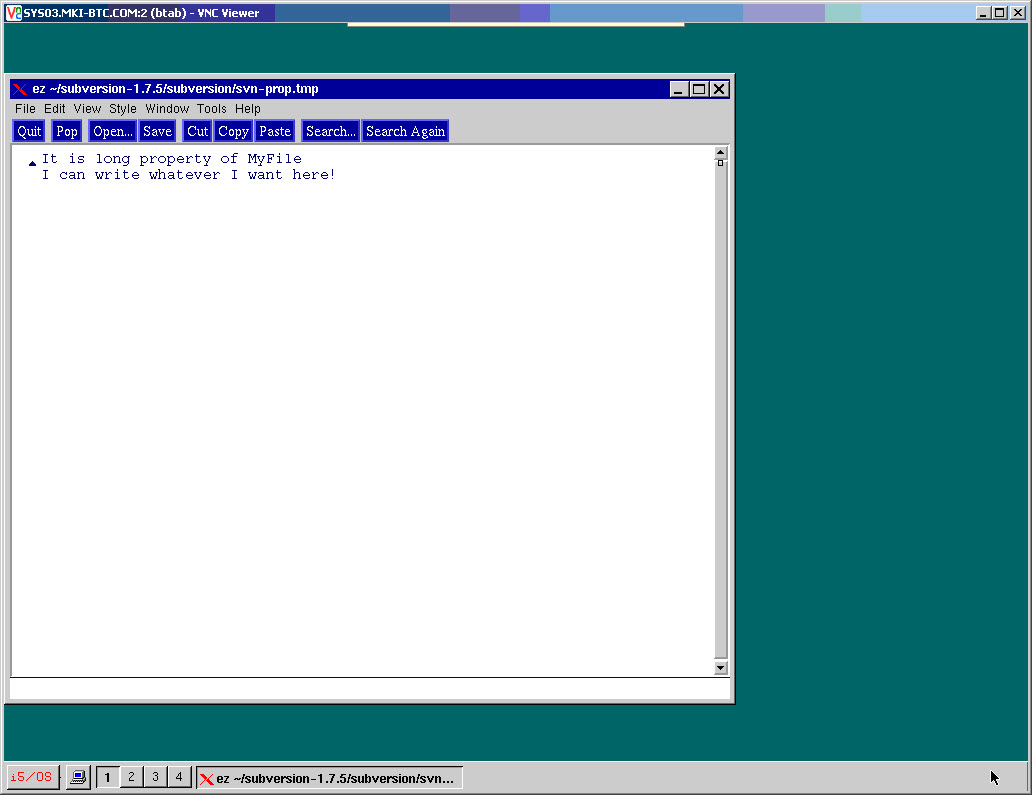

Svn Omit externalsĪll you have to do is right click on your checked out directory (or just anywhere in the white space in Windows explorer if you're inside the folder), go to Tortoise SVN > Properties. To add a new external, click the New and then fill in the required information in the shown dialog. In the properties dialog, either double click on the svn:externals if it already exists, or click on the New button and select externals from the menu.
SVN PROPEDIT MANUAL
"Because the svn:externals property has a multiline value, we strongly recommend that you use svn propedit instead of svn propset." - This is from the manual and relevant as soon as you have more than one external per directory.

Right click and you can see remove option which will remove the link. I came across this problem in order to do it through eclipse you can do the following Go to the root folder where your external is present and right-click Team>Show properties> you should see a name value pair with name as svn:external and value as the external repository. Our first idea (the one which did not imply thinking) was to SVN-export library files from the remote repository, paste them into the project, SVN-add them, then SVN-commit files. Simple introduction to SVN externals Not so long ago, we’ve had to include a third-party library into a new project (using SVN). Using property svn:externals you can tell subversion to fetch content of external repository into a given directory.
SVN PROPEDIT CODE
when you have a repository with common code useful in multiple projects. Subversion has a way of including the content of one repository in another repository. In Subversion, you declare externals definitions in groups using the svn:externals property. When you save and exit the properties are written to that folderīy default svn add is recursive so all files and folders in the folder you add will be added automatically.An externals definition is a mapping of a local directory to the URL-and ideally a particular revision-of a versioned directory. This opens up your chosen editor ( ENV variable EDITOR=editor) so you can add your ignore files/folders.

Run this command from the folder above the files/folders that should be ignored: svn propedit svn:ignore. This ignores hidden files/folders (all which name starts with a dot (.)), all files/folders called old or tmp and all files ending with. In the section in your subversion conf file (OS X: /User//.subversion/conf) there is a setting called global-ignoresĮxample: global-ignores =. Resolve command: svn resolve -accept resolvetype filename Removing the changes you don’t want and keeping the ones that you want on a row by row basis working: this is the option if you want to do a manual merge of the file.base: use the version you used before making any changes.theirs-full: use the latest version in the repository.NOTE You have to stand inside the working directory for the command to work To commit more then one file just place their path after the first ‘filename’Ĭheck status of your working copy svn status

To see another revision use (at the end of the path)Ĭommit changes (all files) svn commit -m"" Use ‘svn://…’ for remote ‘look’ in the same way as with checkout. List svn directory (to look at directory contents) svn list file:/// path/to/repository/trunk).Ĭheckout remote (with svnserve running on server) svn co svn:///Ĭheckout remote (svnserve and authentication) svn co -username= svn:/// NOTE If you are using branches/tags/trunk structure don’t forget to include it in the path (eq. Import a project into remote server (running svnserve on server) svn import /path/to/files/to/import svn:///path/to/repository -m "Initial import" Import a project locally svn import /path/to/files/to/import file:///path/to/repository -m "Initial import" This will create a repository at your current location named “project1” Here is my “Cheat sheet” for the Subversion version system


 0 kommentar(er)
0 kommentar(er)
